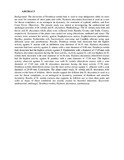Antibacterial and Antifungal Activity of Dombeya torrida (J.F. Gmel) and Hydnora abyssinica (A. Braun)
Date
2014Author
Ndwigah, Stanley N
Amugune, Beatrice K
Thoithi, Grace N
Mwangi, Julius W
Mugo, Hannington N
Kibwage, IO
Type
ArticleLanguage
enMetadata
Show full item recordAbstract
Background: The decoction of Dombeya torrida bark is used to treat indigestion while its roots are used for treatment of chest pains and colds. Hydnora abyssinica decoction is used as a cure for throat complaints, as an astringent in dysentery, for treatment of typhoid, anthrax, and East Coast Fever.
Objectives: The present study was aimed at investigating the antibacterial and antifungal activities of D. torrida and H. abyssinica.
Methodology: The D. torrida stem-bark and leaves and H. abyssinica whole plant were collected from Kiambu County and Embu County, respectively. Extraction of the plants was carried out using chloroform, methanol and water. The extracts were screened for activity against Staphylococcus aureus, Staphylococcus epididermis, Bacillus pumilus, Escherichia coli, Saccromyces cerevisiae and Candida albicans using agar diffusion assay and autobioassay.
Results: Dombeya torrida bark decoction had the highest activity against S. aureus with an inhibition zone diameter of 16.91 mm. Hydnora abyssinica macerate had least activity against S. aureus with a zone diameter of 8.86 mm. Dombeya torrida bark decoction had the highest activity against S. Epididermis with a diameter of 17.05 mm with Hydnora abyssinica macerate having the least activity. Activity against E. coli was highest for D. torrida bark decoction with zone diameter of 16.56 mm. Hydnora abyssinica chloroform extract had the highest activity against B. pumilus with a zone diameter of 17.04 mm. The highest activity observed against S. cerevisiae was with D. torrida chloroform extract with a zone diameter of 17.69 mm with H. abyssinica macerate having the least activity (7.70 mm). Dombeya torrida chloroform extract was the most active extract against C. albicans with a zone diameter of 20.09 mm.
Conclusion: The plants under study, D. torrida and H. abyssinica were chosen on the basis of folklore. Above results support the folklore that H. abyssinica is used as a cure for throat complaints, as an astringent in dysentery, treatment of diarrhoea and amoebic dysentery. Results of D. torrida extracts also supports its folklore use to treat chest pains and colds as many of these conditions are usually caused by bacterial infections.
Keywords: antibacterial, antifungal, Dombeya torrida, Hydnora abyssinica, autobioassay
Citation
Stanley N Ndwigah, Beatrice K Amugune, Grace N Thoithi, Julius W Mwangi, Hannington N Mugo, Isaac O Kibwage(2014). Afr. J. Pharmacol. Ther. 2014. 3(1): 14-18Publisher
University of Nairobi
Collections
- Faculty of Health Sciences (FHS) [10387]

